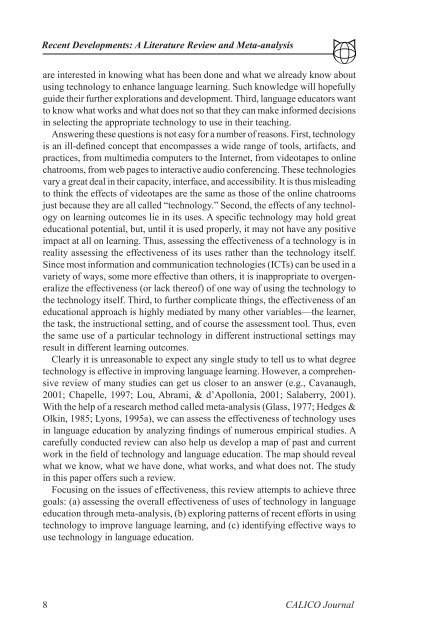Recent Developments in Technology and Language ... - CALICO
Recent Developments in Technology and Language ... - CALICO
Recent Developments in Technology and Language ... - CALICO
Create successful ePaper yourself
Turn your PDF publications into a flip-book with our unique Google optimized e-Paper software.
<strong>Recent</strong> <strong>Developments</strong>: A Literature Review <strong>and</strong> Meta-analysis<br />
are <strong>in</strong>terested <strong>in</strong> know<strong>in</strong>g what has been done <strong>and</strong> what we already know about<br />
us<strong>in</strong>g technology to enhance language learn<strong>in</strong>g. Such knowledge will hopefully<br />
guide their further explorations <strong>and</strong> development. Third, language educators want<br />
to know what works <strong>and</strong> what does not so that they can make <strong>in</strong>formed decisions<br />
<strong>in</strong> select<strong>in</strong>g the appropriate technology to use <strong>in</strong> their teach<strong>in</strong>g.<br />
Answer<strong>in</strong>g these questions is not easy for a number of reasons. First, technology<br />
is an ill-def<strong>in</strong>ed concept that encompasses a wide range of tools, artifacts, <strong>and</strong><br />
practices, from multimedia computers to the Internet, from videotapes to onl<strong>in</strong>e<br />
chatrooms, from web pages to <strong>in</strong>teractive audio conferenc<strong>in</strong>g. These technologies<br />
vary a great deal <strong>in</strong> their capacity, <strong>in</strong>terface, <strong>and</strong> accessibility. It is thus mislead<strong>in</strong>g<br />
to th<strong>in</strong>k the effects of videotapes are the same as those of the onl<strong>in</strong>e chatrooms<br />
just because they are all called “technology.” Second, the effects of any technology<br />
on learn<strong>in</strong>g outcomes lie <strong>in</strong> its uses. A specific technology may hold great<br />
educational potential, but, until it is used properly, it may not have any positive<br />
impact at all on learn<strong>in</strong>g. Thus, assess<strong>in</strong>g the effectiveness of a technology is <strong>in</strong><br />
reality assess<strong>in</strong>g the effectiveness of its uses rather than the technology itself.<br />
S<strong>in</strong>ce most <strong>in</strong>formation <strong>and</strong> communication technologies (ICTs) can be used <strong>in</strong> a<br />
variety of ways, some more effective than others, it is <strong>in</strong>appropriate to overgeneralize<br />
the effectiveness (or lack thereof) of one way of us<strong>in</strong>g the technology to<br />
the technology itself. Third, to further complicate th<strong>in</strong>gs, the effectiveness of an<br />
educational approach is highly mediated by many other variables—the learner,<br />
the task, the <strong>in</strong>structional sett<strong>in</strong>g, <strong>and</strong> of course the assessment tool. Thus, even<br />
the same use of a particular technology <strong>in</strong> different <strong>in</strong>structional sett<strong>in</strong>gs may<br />
result <strong>in</strong> different learn<strong>in</strong>g outcomes.<br />
Clearly it is unreasonable to expect any s<strong>in</strong>gle study to tell us to what degree<br />
technology is effective <strong>in</strong> improv<strong>in</strong>g language learn<strong>in</strong>g. However, a comprehensive<br />
review of many studies can get us closer to an answer (e.g., Cavanaugh,<br />
2001; Chapelle, 199 ; Lou, Abrami, & d’Apollonia, 2001; Salaberry, 2001).<br />
With the help of a research method called meta-analysis (Glass, 19 ; Hedges &<br />
Olk<strong>in</strong>, 19 5; Lyons, 1995a), we can assess the effectiveness of technology uses<br />
<strong>in</strong> language education by analyz<strong>in</strong>g f<strong>in</strong>d<strong>in</strong>gs of numerous empirical studies. A<br />
carefully conducted review can also help us develop a map of past <strong>and</strong> current<br />
work <strong>in</strong> the field of technology <strong>and</strong> language education. The map should reveal<br />
what we know, what we have done, what works, <strong>and</strong> what does not. The study<br />
<strong>in</strong> this paper offers such a review.<br />
Focus<strong>in</strong>g on the issues of effectiveness, this review attempts to achieve three<br />
goals: (a) assess<strong>in</strong>g the overall effectiveness of uses of technology <strong>in</strong> language<br />
education through meta-analysis, (b) explor<strong>in</strong>g patterns of recent efforts <strong>in</strong> us<strong>in</strong>g<br />
technology to improve language learn<strong>in</strong>g, <strong>and</strong> (c) identify<strong>in</strong>g effective ways to<br />
use technology <strong>in</strong> language education.<br />
<strong>CALICO</strong> Journal
















